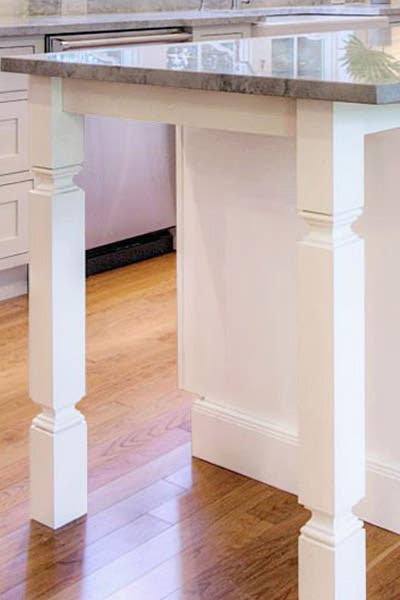Vital Elements to Think About When Selecting Legs For Kitchen Island
Picking the ideal legs for a cooking area island entails a careful analysis of several aspects that can considerably affect both functionality and visual allure. As we check out these components, it ends up being clear that each choice can have far-reaching ramifications for the total kitchen area experience.
Material Options
When picking legs for a kitchen island, comprehending the different product options is vital for achieving both visual allure and structural stability (Legs For Kitchen Island). The option of material considerably affects not only the durability of the island however additionally its total design and performance
Metal legs, frequently made from stainless steel or wrought iron, contribute a contemporary and industrial feel while guaranteeing resilience and security. These products are resistant to wear and can sustain considerable weight, making them suitable for larger islands.
One more choice is engineered materials, like MDF or plywood, which can be more cost-effective while still using a variety of finishes. They may not provide the same degree of security as solid wood or metal. Legs For Kitchen Island. Products such as acrylic or glass can develop a modern look, though they might need additional assistance to make sure stability.
Inevitably, the option of product for kitchen island legs need to line up with the wanted capability and the general theme of the cooking area.
Design And Style

When considering style, the shape and surface of the legs are important. Conical legs can supply a feeling of agility and sophistication, while thicker, a lot more durable legs can communicate stamina and security. Furthermore, the surface-- be it painted, stained, or natural-- should complement the cabinetry and kitchen counter products to develop a unified appearance.
Additionally, the style of the legs can likewise reflect personal preference. Personalized or ornamental legs, such as those including elaborate carvings or unique geometric forms, can function as focal points, adding personality and individuality to the kitchen area. Eventually, the best choice will certainly not just enhance functionality yet likewise elevate the aesthetic allure, making the kitchen area island a standout feature of the home.
Elevation Factors To Consider
Picking the appropriate elevation for kitchen island legs is vital, as it directly affects both capability and comfort. The common height for a kitchen area island usually ranges from 36 to 42 inches, lining up with usual countertop heights.

It is also important to make up individuals' heights and choices. Personalizing the elevation can make sure a comfortable experience for all member of the family, making the cooking area island an extra pleasurable and functional area.
Weight Support
Making certain appropriate weight support for cooking area island legs is important for both safety and security and performance. The cooking area island commonly serves several objectives, consisting of great site food preparation, dining, and added storage, demanding a robust assistance framework. When choosing legs, it is critical to think about the general weight ability called for based upon the island's planned usage and the materials that will certainly be put on it.
The selection of product for the legs plays a substantial duty in their weight-bearing capacities. Solid wood, steel, and durable composites generally offer remarkable strength contrasted to lighter products. In addition, the design of the legs-- whether they are straight, tapered, or have a pedestal form-- can affect their capacity to distribute weight effectively throughout the framework.
Moreover, the leg placement must be purposefully planned to improve security. Legs placed at the edges or with a wider base can much better support heavier loads. Always seek advice from the supplier's specifications concerning tons limitations to make sure that the legs can maintain the designated weight without jeopardizing safety. In recap, picking kitchen area island legs with appropriate weight support is necessary for developing a secure and useful cooking space.
Setup and Maintenance
Correct installation and upkeep of kitchen island legs are critical for making sure longevity and security. This typically involves protecting the legs to the island base using proper fasteners, making sure that the legs are level and lined up.
As soon as set up, normal maintenance is necessary to maintain the integrity and look of the legs - Legs For Kitchen Island. For wood legs, regular cleansing with a damp fabric and application of ideal wood gloss can protect against wetness damage and maintain their surface. Metal legs might require a gentle cleansing service to remove grease and crud, adhered to by a dry fabric to avoid rust development
In addition, evaluate the legs consistently for signs of wear or damage, such as cracks or loose joints. Tightening up screws or bolts as needed can likewise extend the life-span of the legs. By sticking to these installment and upkeep practices, property owners can you could try here guarantee that their kitchen area island stays strong and aesthetically appealing for many years to find.
Final Thought

Visual comprehensibility is paramount in selecting the style and style of legs for a cooking area island, as these elements significantly affect the total ambiance of the space. Tapered legs can offer a feeling of agility and style, while thicker, extra robust legs can convey strength and stability.Choosing the suitable elevation for kitchen area island legs is critical, as it straight influences both capability and convenience. In recap, picking cooking area island legs with adequate weight assistance is essential for creating a functional and safe culinary space.
In conclusion, selecting legs for a cooking area island demands mindful factor to consider of numerous aspects, including material options, style, elevation, weight support, and installment.